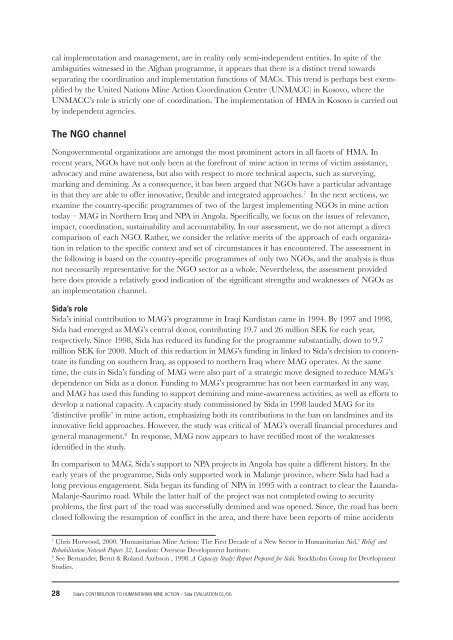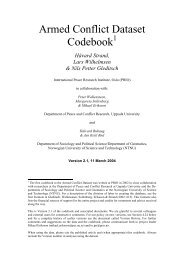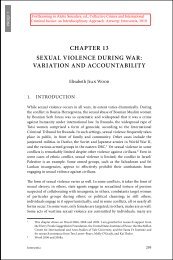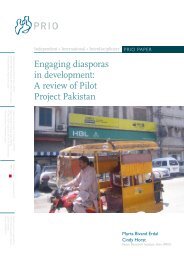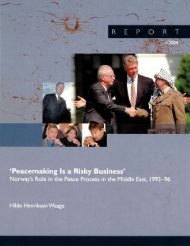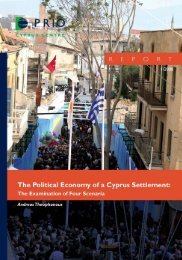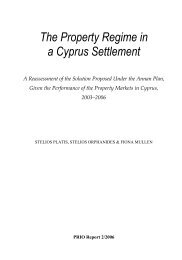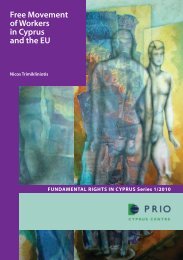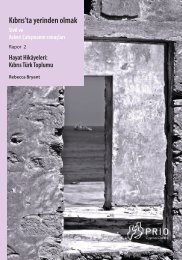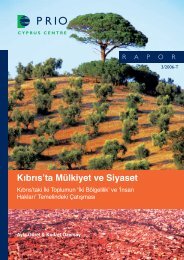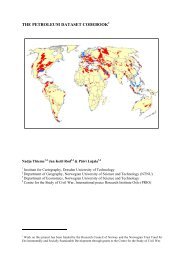cal implementation and management, are in reality only semi-independent entities. In spite of theambiguities witnessed in the Afghan programme, it appears that there is a distinct trend <strong>to</strong>wardsseparating the coordination and implementation functions of MACs. This trend is perhaps best exemplifiedby the United Nations <strong>Mine</strong> <strong>Action</strong> Coordination Centre (UNMACC) in Kosovo, where theUNMACC’s role is strictly one of coordination. The implementation of HMA in Kosovo is carried outby independent agencies.The NGO channelNongovernmental organizations are amongst the most prominent ac<strong>to</strong>rs in all facets of HMA. Inrecent years, NGOs have not only been at the forefront of mine action in terms of victim assistance,advocacy and mine awareness, but also with respect <strong>to</strong> more technical aspects, such as surveying,marking and demining. As a consequence, it has been argued that NGOs have a particular advantagein that they are able <strong>to</strong> offer innovative, flexible and integrated approaches. 7 In the next sections, weexamine the country-specific programmes of two of the largest implementing NGOs in mine action<strong>to</strong>day – MAG in Northern Iraq and NPA in Angola. Specifically, we focus on the issues of relevance,impact, coordination, sustainability and accountability. In our assessment, we do not attempt a directcomparison of each NGO. Rather, we consider the relative merits of the approach of each organizationin relation <strong>to</strong> the specific context and set of circumstances it has encountered. The assessment inthe following is based on the country-specific programmes of only two NGOs, and the analysis is thusnot necessarily representative for the NGO sec<strong>to</strong>r as a whole. Nevertheless, the assessment providedhere does provide a relatively good indication of the significant strengths and weaknesses of NGOs asan implementation channel.Sida’s roleSida’s initial contribution <strong>to</strong> MAG’s programme in Iraqi Kurdistan came in 1994. By 1997 and 1998,Sida had emerged as MAG’s central donor, contributing 19.7 and 26 million SEK for each year,respectively. Since 1998, Sida has reduced its funding for the programme substantially, down <strong>to</strong> 9.7million SEK for 2000. Much of this reduction in MAG’s funding in linked <strong>to</strong> Sida’s decision <strong>to</strong> concentrateits funding on southern Iraq, as opposed <strong>to</strong> northern Iraq where MAG operates. At the sametime, the cuts in Sida’s funding of MAG were also part of a strategic move designed <strong>to</strong> reduce MAG’sdependence on Sida as a donor. Funding <strong>to</strong> MAG’s programme has not been earmarked in any way,and MAG has used this funding <strong>to</strong> support demining and mine-awareness activities, as well as efforts <strong>to</strong>develop a national capacity. A capacity study commissioned by Sida in 1998 lauded MAG for its’distinctive profile’ in mine action, emphasizing both its contributions <strong>to</strong> the ban on landmines and itsinnovative field approaches. However, the study was critical of MAG’s overall financial procedures andgeneral management. 8 In response, MAG now appears <strong>to</strong> have rectified most of the weaknessesidentified in the study.In comparison <strong>to</strong> MAG, Sida’s support <strong>to</strong> NPA projects in Angola has quite a different his<strong>to</strong>ry. In theearly years of the programme, Sida only supported work in Malanje province, where Sida had had along previous engagement. Sida began its funding of NPA in 1995 with a contract <strong>to</strong> clear the Luanda-Malanje-Saurimo road. While the latter half of the project was not completed owing <strong>to</strong> securityproblems, the first part of the road was successfully demined and was opened. Since, the road has beenclosed following the resumption of conflict in the area, and there have been reports of mine accidents7Chris Horwood, 2000. ’<strong>Humanitarian</strong> <strong>Mine</strong> <strong>Action</strong>: The First Decade of a New Sec<strong>to</strong>r in <strong>Humanitarian</strong> Aid,’ Relief andRehabilitation Network Papers 32, London: Overseas Development Institute.8See Bernander, Bernt & Roland Axelsson , 1998. A Capacity Study: Report Prepared for Sida. S<strong>to</strong>ckholm Group for DevelopmentStudies.28 Sida’s CONTRIBUTION TO HUMANITARIAN MINE ACTION – Sida EVALUATION 01/06
in the region. Sida’s original funding <strong>to</strong> NPA <strong>to</strong>ok place in close cooperation with Swedrelief, whichwas in charge of bridge construction and the reparation of cleared roads. Sida’s support has nowexpanded beyond Malanje; from 2000, Sida funding will not be earmarked or restricted <strong>to</strong> a particulargeographical area, but will be provided <strong>to</strong> specific clearance projects.Assessment of NGOs as implementersRelevanceMAG’s first field program in Northern Iraq was launched in 1992. 9 At the time, MAG was the onlyinternationally recognized HMA organization working in Northern Iraq. This remained the case until1995, when NPA initiated its programme, followed by the UN in late 1997. MAG’s Northern Iraqprogramme is its largest, most developed and the one MAG views as most representative of its basicphilosophy. At the same time, the programme is not recognized by the Baghdad government. WhenMAG began its involvement in Northern Iraq, the mine threat <strong>to</strong> the region was severe. Because themine situation in the region remains serious, it is likely <strong>to</strong> warrant substantial and sustained activity foryears <strong>to</strong> come. MAG’s early response was key, both in terms of initiating an on-the-ground effort andin bringing international focus <strong>to</strong> the problem.In its initial phases, MAG’s programme in Iraq was a relatively conventional effort. However, the threa<strong>to</strong>f major funding reductions, combined with operational problems due <strong>to</strong> difficulties in securing thesupply of equipment, led <strong>to</strong> a search for innovative responses. A first example of this is the largest demarcationeffort in recent HMA his<strong>to</strong>ry. Such projects are important in that they have the potential <strong>to</strong> reducethe immediate threat of landmines and may in certain situations be a cost-efficient response. By the endof 1998, MAG had marked 1,130 of the 2,300 minefields registered in its database. A second, andperhaps even more important innovation, is that of <strong>Mine</strong> <strong>Action</strong> Teams (MATs). The concept of MATsdeveloped from MAG’s experience with its Angola project. In Angola, MAG had experimented withmulti-skill teams that combined Participa<strong>to</strong>ry Rural Appraisal (PRA) – inspired information gathering,locally tailored mine awareness and UXO clearance. 10 In Northern Iraq, MATs combine demining,survey and mine awareness. The basic component of MATs is a demining unit consisting of three persons,most commonly a team leader and two deminers, although MATs can be as large as 18 persons.The team is responsible for ’Community Liaison’, which includes information exchange with the community,impact moni<strong>to</strong>ring and mine awareness. MATs do not always work as one unit. Components of eachteam can work separately or can be used in conjunction with other teams. Overall, the MAT conceptstands out as one of the few alternative organizational approaches <strong>to</strong> HMA, owing <strong>to</strong> its flexibility andthe unique way in which it integrates the various components of mine action.In Angola, ongoing hostilities and re-mining by both parties (government and UNITA) as an activeconflict strategy have led <strong>to</strong> the strong politicization of demining. The Angolan mine problem has beencategorized as severe, despite the absence of a thorough impact assessment. Re-mining, political andsecurity issues have placed severe constraints on demining work. In light of the general situation inAngola, the relevance of a particular programme becomes inextricably linked <strong>to</strong> the agency’s ability <strong>to</strong>respond <strong>to</strong> the changing needs of the population. It is evident that impact assessments are a necessityof HMA globally. The same can be said of understanding the context and being flexible in the wayoperations are conducted. In the case of Angola, both are fundamental issues that will be key in ensur-9The evaluation team could not visit Northern Iraq. The following is based on interviews during a two-day visit <strong>to</strong> MAGheadquarters in Manchester and a review of documentation from MAG’s and Sida’s archives. In addition, we have had access<strong>to</strong> a recent evaluation report conducted for DFID: J. A. Craib, 2001. Report on Visit <strong>to</strong> Northern Iraq, Draft, Kent: BaricConsultants.10Justin Brady, 1997. A New Paradigm in <strong>Mine</strong> <strong>Action</strong>: <strong>Mine</strong> <strong>Action</strong> Teams in Moxico, Angola, Draft, 11 November.Sida’s CONTRIBUTION TO HUMANITARIAN MINE ACTION – Sida EVALUATION 01/06 29
- Page 4: This report is part of Sida Evaluat
- Page 9 and 10: MDDMEDDSMGMMLSWMoPHMOUMPLANATONDING
- Page 12 and 13: the conclusions of this report is t
- Page 14 and 15: A prime concern with Mine Action Ce
- Page 16 and 17: 3. The coordination of mine action,
- Page 18 and 19: an needs and the needs of victims o
- Page 20 and 21: At the same time as Sida has been o
- Page 22 and 23: er, throughout the data collection,
- Page 24 and 25: Donors may feel that the costs of i
- Page 26 and 27: is genuinely new. 8 At an overall l
- Page 28 and 29: The first attempt to apply a form o
- Page 30 and 31: standard for basic impact surveys.
- Page 32 and 33: Community studiesCommunity studies
- Page 34 and 35: and progress monitored in all phase
- Page 36 and 37: 3 Implementation ChannelsOver the p
- Page 40 and 41: ing that demining has any effect at
- Page 42 and 43: actual response. In an effort to ov
- Page 44 and 45: ecently developed. The approaches t
- Page 46 and 47: A different tool that will be used
- Page 48 and 49: Alternative implementation channels
- Page 50 and 51: appear to have been doing a good jo
- Page 52 and 53: Coordination may at times even be c
- Page 54 and 55: itarian and development effort. Imp
- Page 56 and 57: Two). In terms of coordinating mine
- Page 58 and 59: ased demining of AREA. Another type
- Page 60 and 61: The Kosovo UNMACC took a number of
- Page 62 and 63: would be accredited and tasked by U
- Page 64 and 65: programme. The proposal was backed
- Page 66 and 67: The present landscape of Swedish ac
- Page 68 and 69: demining purposes. Buoyed by a wave
- Page 70 and 71: given that SRSA also recruits perso
- Page 72 and 73: teams. The need for a breeding capa
- Page 74 and 75: 6 RecommendationsIn the preceding c
- Page 76 and 77: • MACs should operate with agreem
- Page 78 and 79: 7 ConclusionIn this report, we have
- Page 80: 70Appendix 1
- Page 89 and 90:
Ziauddin Operations Officer METADup
- Page 91 and 92:
Bennedich, Claes Department for eva
- Page 93 and 94:
Appendix 3BIBLIOGRAPHYAccelerated D
- Page 95 and 96:
Faulkner, F. & L Pettiford, 1998.
- Page 97 and 98:
McGrath, Rae, 2000. Landmines and U
- Page 99 and 100:
Miscellaneous DocumentsBrady, Justi
- Page 101 and 102:
Appendix 4Sida’s CONTRIBUTION TO
- Page 103 and 104:
Appendix 6• The area must be secu
- Page 105 and 106:
Appendix 7Locality identifier: Dist
- Page 107:
Recent Sida Evaluations00/37:1 Asse


